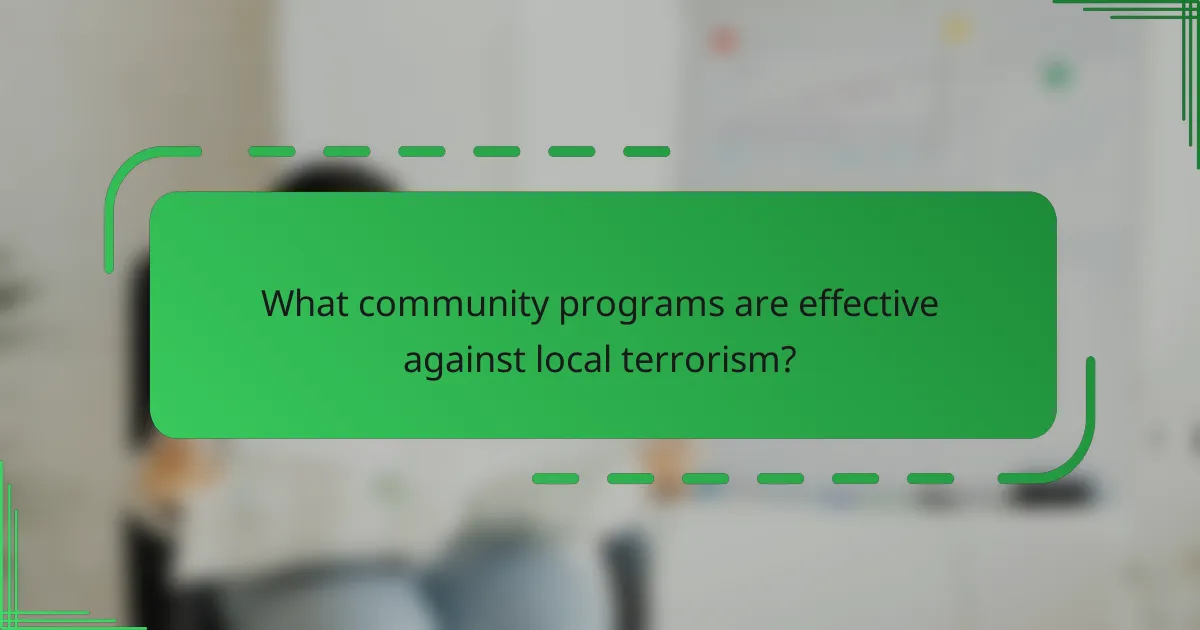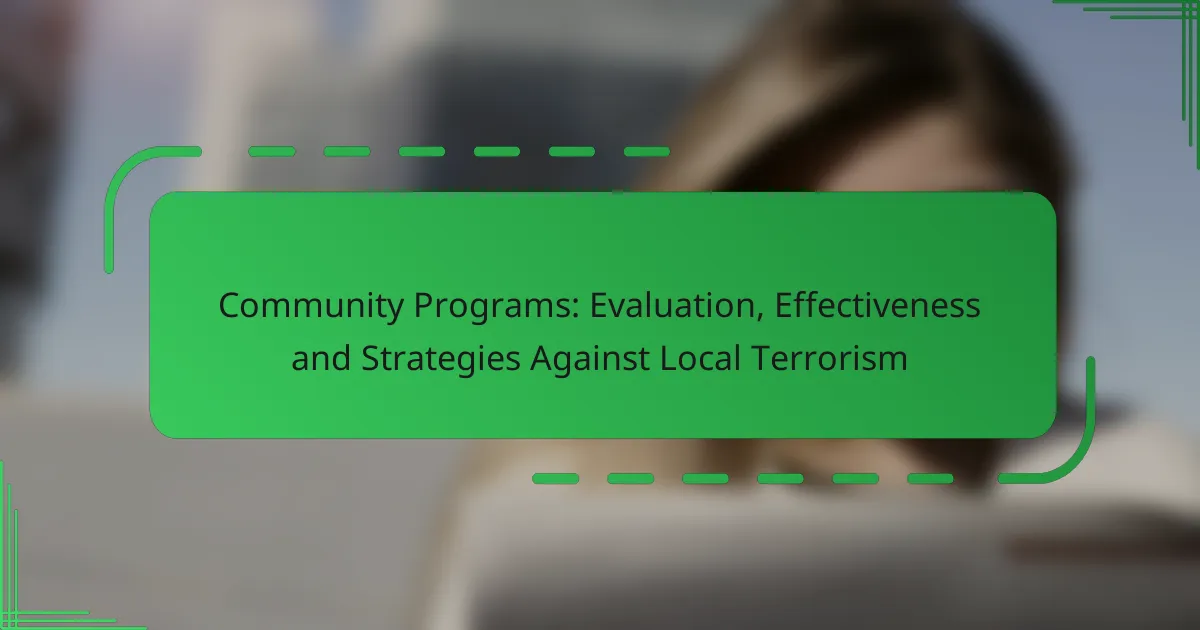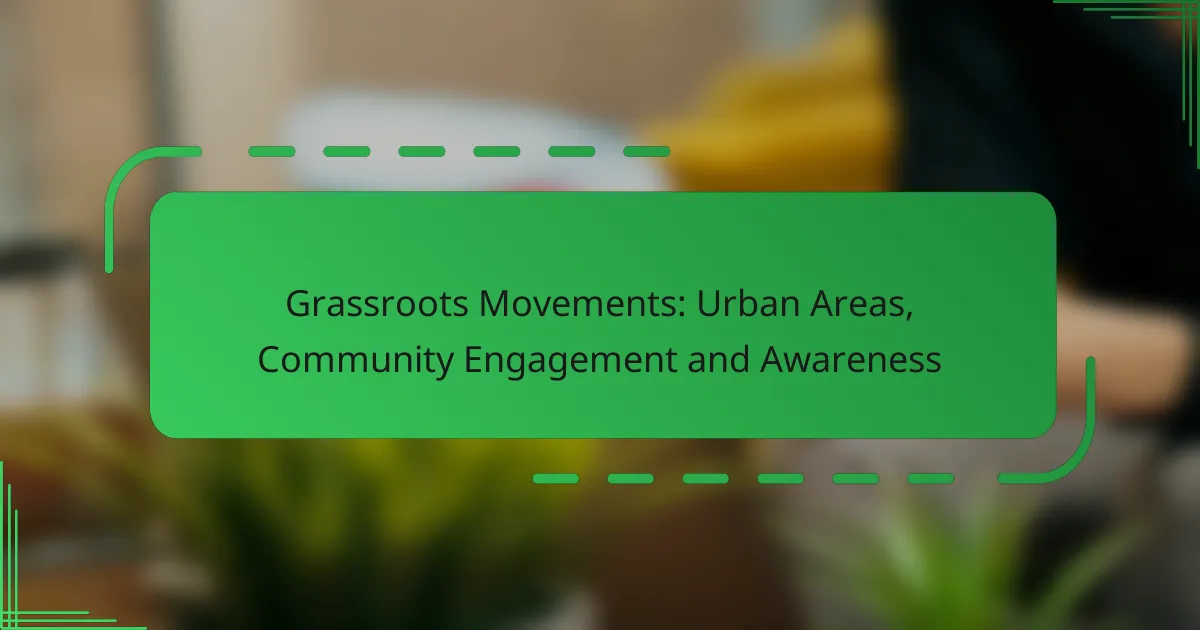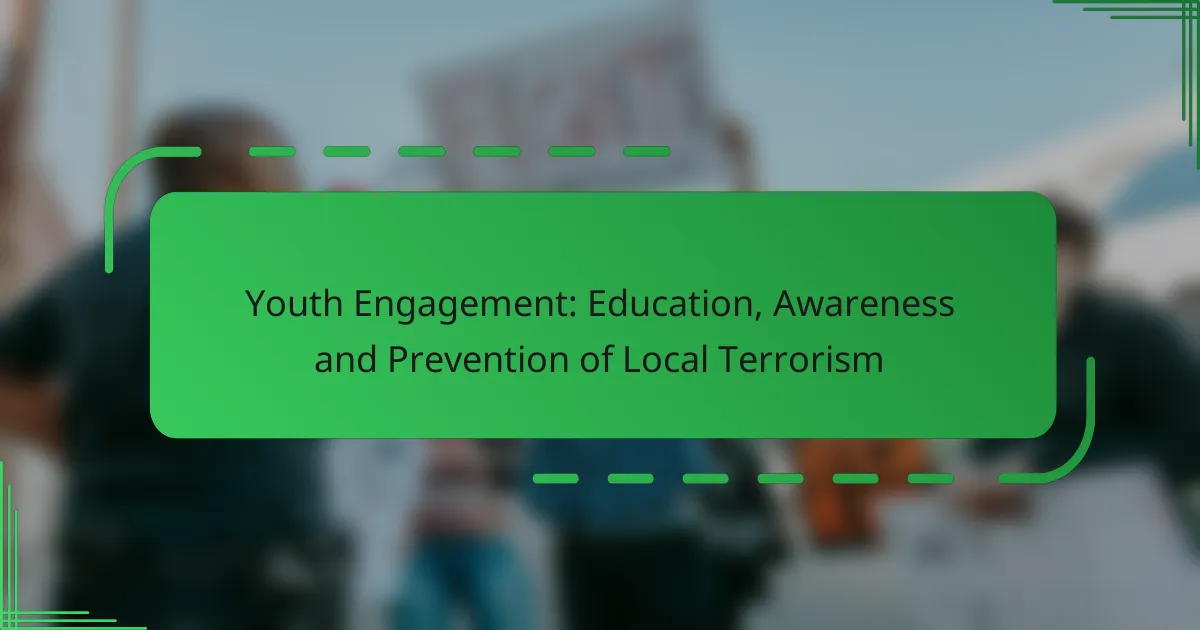Community programs designed to combat local terrorism play a crucial role in building trust and collaboration between residents and law enforcement. By addressing the root causes of radicalization and promoting active participation, these initiatives can significantly mitigate the risk of violence. Evaluating their effectiveness through feedback and crime analysis helps ensure these programs remain impactful and sustainable.

What community programs are effective against local terrorism?
Effective community programs against local terrorism focus on fostering trust, communication, and collaboration among residents and law enforcement. Initiatives that engage community members and address underlying issues can significantly reduce the risk of radicalization and violence.
Neighborhood watch initiatives
Neighborhood watch initiatives empower residents to take an active role in monitoring their communities and reporting suspicious activities. By fostering a sense of vigilance and responsibility, these programs can deter potential threats and enhance community cohesion.
Successful neighborhood watch programs often involve regular meetings, training sessions, and communication with local law enforcement. Residents should be encouraged to share information and collaborate on safety strategies, which can include organizing patrols or community events to strengthen relationships.
Community policing strategies
Community policing strategies focus on building partnerships between law enforcement and community members to address safety concerns collaboratively. This approach emphasizes proactive measures, such as engaging with residents to understand their needs and concerns, rather than solely responding to incidents.
Effective community policing involves regular interaction between police officers and community members, including participation in local events and forums. Officers should be trained in cultural competency to better connect with diverse populations and address specific local issues related to terrorism.
Youth engagement programs
Youth engagement programs are crucial for preventing radicalization among young people by providing positive outlets and support systems. These initiatives can include mentorship, educational workshops, and recreational activities that promote social inclusion and resilience.
Programs should focus on building life skills, fostering critical thinking, and encouraging civic participation. Collaborations with schools, local organizations, and families can enhance the effectiveness of these programs, ensuring that youth feel valued and connected to their communities.
Interfaith dialogue initiatives
Interfaith dialogue initiatives aim to promote understanding and cooperation among different religious communities, reducing tensions that can lead to local terrorism. By facilitating conversations and shared activities, these programs can help dispel myths and foster mutual respect.
Successful interfaith initiatives often involve workshops, community service projects, and cultural exchanges that highlight common values. Engaging diverse religious leaders and community members in these dialogues can create a united front against extremism and promote social harmony.

How do community programs evaluate their effectiveness?
Community programs assess their effectiveness through various methods that provide insights into their impact on local terrorism. These evaluations often include gathering feedback, analyzing crime rates, and measuring community engagement to determine the overall success of the initiatives.
Surveys and feedback mechanisms
Surveys and feedback mechanisms are essential tools for evaluating community programs. They allow participants to express their perceptions and experiences, providing qualitative data that can highlight strengths and weaknesses. Regularly conducting surveys can help track changes over time and identify areas needing improvement.
When designing surveys, consider using a mix of quantitative and qualitative questions. For instance, a scale from 1 to 5 can gauge satisfaction levels, while open-ended questions can capture detailed feedback. Aim for a response rate of at least 30% to ensure the data is representative.
Crime rate analysis
Analyzing crime rates is a critical component of evaluating community programs aimed at reducing local terrorism. By examining trends in crime statistics before and after program implementation, stakeholders can assess whether there has been a significant decrease in incidents related to terrorism. This analysis often involves comparing data over multiple years to account for fluctuations.
It is useful to focus on specific types of crime, such as hate crimes or violent incidents, that may correlate with terrorism. Collaborating with local law enforcement can provide access to accurate data and enhance the evaluation process.
Community engagement metrics
Community engagement metrics measure the level of participation and involvement in programs designed to combat local terrorism. High engagement levels often correlate with program effectiveness, as they indicate community buy-in and support. Metrics can include attendance at events, volunteer hours, and participation in discussions or workshops.
To effectively track engagement, consider setting clear goals for participation and using tools like sign-up sheets or digital platforms to monitor involvement. Regularly review these metrics to adjust strategies and improve outreach efforts, ensuring that programs remain relevant and impactful.

What are the best practices for implementing community programs?
Effective community programs against local terrorism rely on collaboration, active participation, and continuous education. Best practices include engaging local stakeholders, fostering partnerships, and providing ongoing training to ensure the programs are impactful and sustainable.
Collaboration with local law enforcement
Collaboration with local law enforcement is crucial for the success of community programs. Building strong relationships fosters trust and ensures that community concerns are addressed promptly. Regular meetings and joint initiatives can enhance communication and coordination.
Establishing a clear communication channel between community members and law enforcement can help identify potential threats early. Programs may include neighborhood watch schemes or community policing initiatives that encourage residents to report suspicious activities.
Involvement of community leaders
Involving community leaders is essential for gaining buy-in and ensuring the program resonates with local values. Leaders can act as liaisons, helping to disseminate information and mobilize community members. Their endorsement can significantly enhance participation rates.
Community leaders should be included in planning and decision-making processes to ensure programs reflect the needs and concerns of the community. Regular forums or town hall meetings can provide a platform for dialogue and feedback.
Regular training and workshops
Regular training and workshops are vital for equipping community members with the skills needed to recognize and respond to potential threats. These sessions can cover topics such as conflict resolution, emergency response, and awareness of radicalization signs.
Workshops should be tailored to the community’s specific context and needs, with practical exercises that encourage participation. Consider partnering with local organizations or experts to deliver these trainings effectively, ensuring they are accessible and relevant.

What challenges do community programs face?
Community programs aimed at countering local terrorism encounter several significant challenges that can hinder their effectiveness. These obstacles include limited funding, community resistance, and difficulties in coordinating efforts among various stakeholders.
Lack of funding and resources
Insufficient funding is a primary challenge for community programs, often leading to inadequate staffing and limited outreach capabilities. Many initiatives rely on grants or donations, which can be unpredictable and may not cover all necessary expenses.
To mitigate funding issues, programs should explore diverse funding sources, including government grants, private donations, and partnerships with local businesses. Establishing a clear budget and demonstrating program effectiveness can attract more financial support.
Community resistance and mistrust
Community resistance and mistrust can significantly impede the success of programs designed to combat terrorism. Residents may be skeptical of government involvement or fear that their participation could lead to surveillance or profiling.
Building trust requires consistent engagement with the community, transparency in operations, and a focus on addressing local concerns. Programs should prioritize open dialogue, involve community leaders, and demonstrate their commitment to the community’s well-being.
Coordination among stakeholders
Effective coordination among stakeholders, including law enforcement, local governments, and community organizations, is crucial for program success. However, differing priorities and communication barriers can complicate collaboration.
To enhance coordination, stakeholders should establish regular meetings, share resources, and create a unified strategy that aligns with community needs. Utilizing technology for communication and project management can also streamline efforts and improve outcomes.

How can local governments support community programs?
Local governments can support community programs by providing essential resources, fostering collaborations, and ensuring access to training. These actions create a robust framework that empowers communities to effectively address local terrorism and enhance public safety.
Providing grants and funding
Grants and funding are vital for community programs aimed at countering local terrorism. Local governments can allocate budgetary resources or seek federal and state grants to support initiatives that promote community engagement and resilience.
For example, a city might offer grants ranging from a few thousand to tens of thousands of dollars to organizations that develop educational workshops or outreach programs. Ensuring that funding is accessible and well-publicized can significantly increase participation and impact.
Facilitating partnerships
Facilitating partnerships between local organizations, law enforcement, and community leaders enhances the effectiveness of programs. Local governments can act as a bridge, connecting various stakeholders to share resources, knowledge, and best practices.
For instance, a local government might organize regular meetings between schools, non-profits, and police departments to discuss strategies and coordinate efforts. This collaboration can lead to innovative solutions tailored to the specific needs of the community.
Offering training and resources
Offering training and resources equips community members with the skills necessary to recognize and respond to potential threats. Local governments can provide workshops, seminars, and materials that focus on safety awareness and emergency preparedness.
Training sessions could cover topics such as conflict resolution, recognizing suspicious behavior, and emergency response protocols. Providing these resources not only empowers individuals but also fosters a culture of vigilance and cooperation within the community.

What role do educational institutions play in community programs?
Educational institutions play a crucial role in community programs aimed at preventing local terrorism by fostering a culture of understanding and respect among diverse groups. They provide structured environments where students can learn about conflict resolution, engage in critical thinking, and develop social skills that contribute to community cohesion.
Curriculum on conflict resolution
A curriculum focused on conflict resolution equips students with the skills necessary to navigate disagreements peacefully. This includes teaching negotiation techniques, active listening, and empathy, which are essential for reducing tensions in diverse communities.
Implementing such a curriculum can involve role-playing exercises, group discussions, and workshops that encourage students to explore different perspectives. Schools may also collaborate with local organizations to provide real-world scenarios for students to practice their skills.
After-school programs for at-risk youth
After-school programs targeting at-risk youth are vital in providing safe spaces and constructive activities that deter engagement in extremist behaviors. These programs often include mentorship, sports, arts, and community service, which help build resilience and a sense of belonging.
Effective after-school initiatives should focus on fostering relationships between youth and positive role models. Schools can partner with local nonprofits to offer resources and support, ensuring that these programs are accessible and tailored to the specific needs of the community.



